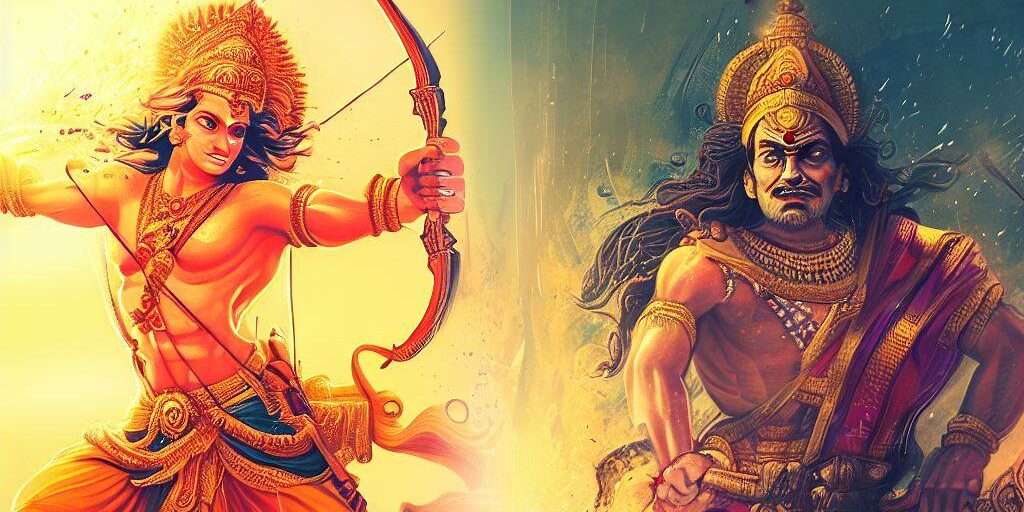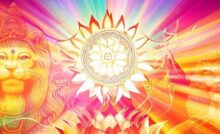The Quintessence of Hindu Mythology: An Insightful Exploration of Ramayana and Mahabharata


The legendary wars of Ramayana and Mahabharata, where heroes clashed and destinies unfolded.
Introduction
Hindu mythology, an integral part of the great Indian cultural fabric, serves as a repository of various intriguing tales and profound wisdom that have, over time, guided the philosophical and moral perspectives of countless generations. Central to these mythical narratives are the two grand epics – the Ramayana and Mahabharata, stories that have not only shaped Hindu thought but have left a significant imprint on the global literary and philosophical landscape. This exploration delves into the intricacies of these monumental epics, their compelling stories, distinguished characters, and their pervasive impact on society.
Understanding The Ramayana: A Tale of Valour, Virtue, and Victory
Often hailed as the epitome of virtue and moral values, the Ramayana is attributed to the sage Valmiki and revolves around the life of Prince Rama. The epic is a grand tapestry of valiant heroes, formidable foes, undying devotion, and ultimate victory of good over evil, enveloped in a narrative that has, over the centuries, transcended the written page to influence real-life societal norms and values.
The Characters of the Ramayana
Lord Rama, the virtuous protagonist, is an embodiment of righteousness, displaying ideal traits of a son, a husband, a warrior, and a king. His wife, Sita, the embodiment of feminine virtue and devotion, stands as an epitome of purity, strength, and resolve, even in the face of adversity. The narrative arc that runs through the epic, illustrating Rama’s trials and tribulations, Sita’s unwavering fidelity, and the eventual triumph of their virtue over the powerful antagonist Ravana, forms the crux of the Ramayana.
The Ramayana weaves several profound themes into its narrative. The victory of good over evil, the power of righteousness, the importance of duty and loyalty, the essence of true devotion, and the concept of Dharma (duty) are all conveyed through captivating tales and unforgettable characters.
Decoding The Mahabharata: An Intricate Mosaic of Philosophy, Power, and Prudence
The Mahabharata, often recognized as the longest epic poem globally, is an intricate mosaic of philosophical discourses, power dynamics, moral dilemmas, and life’s stark realities. Authored by Sage Vyasa, the epic primarily revolves around the struggle for power and the throne of Hastinapura between two groups of cousins – the righteous Pandavas and the ambitious Kauravas.
Characters and Themes of the Mahabharata
Each character in the Mahabharata is complex and multi-dimensional, making the epic a realistic reflection of the human condition. From the Pandavas’ display of virtues and values to the Kauravas’ embodiment of ambition and deceit, every character holds a mirror to the different facets of humanity.
Among the labyrinth of stories in the Mahabharata, the Bhagavad Gita, a discourse between Prince Arjuna and his charioteer, Lord Krishna, holds a prominent place. This episode offers deep insights into life, duty, morality, and the path to salvation. This, coupled with the exploration of themes like Dharma (duty), Karma (action and consequence), and Moksha (liberation), makes the Mahabharata a guidebook for leading a meaningful life.
Drawing Parallels: The Ramayana and Mahabharata
At first glance, the Ramayana and Mahabharata may seem different in their narrative style, character development, and themes. However, a closer look reveals the convergence of these epics on essential aspects of human life – morality, duty, righteousness, love, sacrifice, and the eternal cycle of life and death.
While the Ramayana is primarily a narrative of ideal characters, the Mahabharata deals with characters that embody both virtues and vices, making it relatable and a reflection of real life. Despite these differences, both epics drive home the same fundamental truths about life, duty, and the consequences of actions, serving as lighthouses guiding humanity’s moral compass.
The Legacy of the Epics
Through centuries, the influence of the Ramayana and Mahabharata has transcended the confines of religion and geography. These epics have shaped literature, art, philosophy, and societal norms, continuing to resonate with millions across the globe.
The tales from these epics have been passed down through countless generations, their vibrant narratives influencing not just religious or philosophical thought, but also diverse aspects of everyday life. Festivals, rituals, music, dance, theater, and even popular cinema bear the distinct imprint of these epic narratives. They provide a common thread of cultural continuity, connecting the past with the present, the sacred with the secular.
Conclusion: Inviting Readers to Explore the Profound Wisdom within
The Ramayana and Mahabharata are not mere stories. They are profound explorations of human nature, relationships, and morality, encapsulated in narratives that are as captivating as they are enlightening. These timeless epics have much to offer to the seekers of wisdom, the lovers of literature, and those curious about humanity’s diverse cultural heritage.
As we continue to unravel these epics’ layers, we find a treasure trove of philosophical insights, ethical principles, and narratives that shape our understanding of life, duty, and the path to ultimate truth. They serve as a testament to the rich intellectual and cultural legacy of ancient India and continue to guide and inspire millions worldwide.
As the adage goes, the journey of a thousand miles begins with a single step. The exploration of these epic narratives is indeed a journey, a journey into the heart of a rich and vibrant cultural tradition. It is an invitation to journey deep within, to question, to reflect, and to seek the wisdom that lies hidden in these ancient texts.
Frequently Asked Questions (FAQs)
What are the major differences between the Ramayana and Mahabharata?
The Ramayana is essentially a story of ideals, focusing on the life of Lord Rama and his perfect adherence to Dharma, even under challenging circumstances. The Mahabharata, on the other hand, is a complex epic with an intricate narrative that explores multiple aspects of life and Dharma through its vast array of characters and interwoven subplots. While the Ramayana provides a blueprint for ideal living, the Mahabharata delves deep into the realities and complexities of human life and relationships.
Are the characters in these epics based on real historical figures?
It’s an ongoing debate. While some believe that these epics recount the stories of actual historical figures, others regard them as allegorical tales infused with philosophical and spiritual insights. Irrespective of their historical accuracy, both epics continue to be revered for their universal themes and timeless wisdom.
How have the Ramayana and Mahabharata influenced Indian literature and art?
The influence of these epics on Indian literature and art is immense and profound. Their narratives, characters, and themes have been deeply woven into the Indian literary tradition, inspiring countless works of literature, drama, poetry, dance, and music. They have also shaped various art forms, including painting, sculpture, and temple architecture.
Can non-Hindus benefit from reading these epics?
Absolutely. While the Ramayana and Mahabharata are rooted in Hindu culture and philosophy, their universal themes of morality, duty, love, sacrifice, and the eternal cycle of life and death resonate with individuals across different religious and cultural backgrounds. Their wisdom and insights hold relevance for all those seeking to understand the complexities of life and the human condition.
Are there any modern adaptations of the Ramayana and Mahabharata?
Yes, several modern adaptations of these epics have been created in various mediums, including literature, film, television, and theater, both in India and around the world. These adaptations have reinterpreted the epics in contemporary contexts, making them accessible and relevant to modern audiences.
In Conclusion
In their essence, the Ramayana and Mahabharata serve as mirrors reflecting the truths of human life, society, and the universe. The stories, characters, and teachings encapsulated in these epics have guided humanity for millennia, helping individuals navigate the labyrinth of life with wisdom and moral strength. As we delve deeper into these timeless narratives, we unlock layers of wisdom that continue to illuminate our paths, just as they have lighted the paths of those who walked before us. Delving into these grand epics isn’t just about understanding Hindu mythology; it’s about unraveling the intricate tapestry of human existence.
Further reading
Ramayana and Mahabharata Comparison Overview: https://www.asiahighlights.com/india/ramayana-vs-mahabharata
Recent Posts
5 Key Insights: The Significance of Yoga in Modern Life from a Hindu Perspective
Yoga, an ancient practice rooted deeply in the spiritual soil of Hinduism, has traversed a…
10 Transformative Reasons: The Spiritual Guide to Eating with Hands in Hinduism
Introduction In the age of fast food and instant gratification, the serene practice of eating…
10 Unbreakable Connections Between Hinduism and Environmental Sustainability: A Comprehensive Guide
Introduction Hinduism, one of the world's oldest religions, is more than a mere spiritual path;…
7 Timeless Principles of Non-Violence in Hinduism: A Comprehensive Guide
Introduction: Embracing Non-Violence in Hinduism The Profound Connection Between Non-Violence and Hinduism Non-violence, or Ahimsa,…
7 Transformative Powers of Yagya in Hinduism: A Complete Guide to Spiritual Rituals
Introduction to Yagya in Hinduism: A Spiritual Exploration Yagya, also spelled Yajna, is a profound…
The Deep-rooted Significance of Copper in Hinduism: 7 Enlightening Insights
Introduction Copper, with its gleaming reddish-brown allure, isn't just a metal to the spiritually profound…

